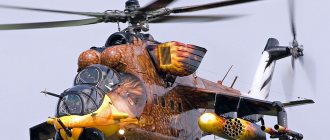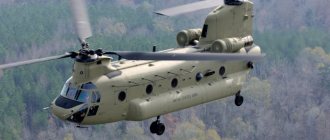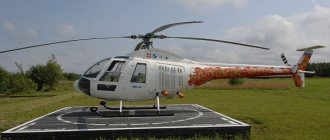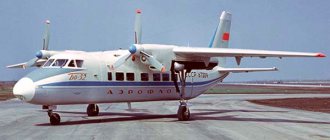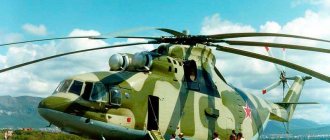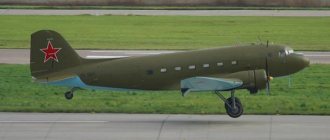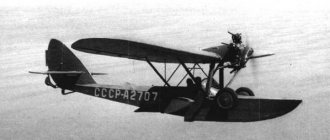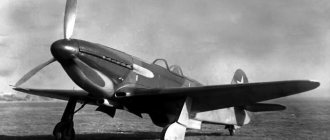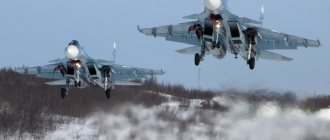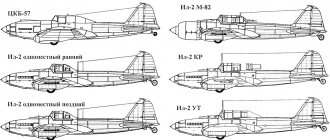The Mi-24 attack helicopter became the first specialized attack vehicle of this type developed in the Soviet Union. And in the world, it lost primacy only to the American AH-1 Cobra helicopter. Designed at the Mil Design Bureau at the turn of the 60-70s of the last century, it is still in service with the army aviation of many countries.
Possessing enormous modernization potential, the helicopter does not lose combat effectiveness and is not inferior to modern competitors in its main parameters. And it was this machine that entered the mass consciousness as a collective image of a Soviet attack helicopter.
History of creation and design of the “crocodile”
The experienced Mi-1MU, armed with Malyutka anti-tank missiles, can be considered the first domestic combat helicopter. This vehicle did not go into production, but the next model, the transport and combat Mi-4AV, was put into service and used in front-line aviation. And in 1967, the USSR Ministry of Defense announced a competition for the creation of a new attack helicopter, in which the Moscow and Ukhtomsk factories took part.
The Kamov Design Bureau project was a variant of the Ka-25 anti-submarine vehicle. Mil Design Bureau proposed the B-24 project. This helicopter, equipped with two powerful TVZ-117 engines, significantly surpassed the Ka-25 in maximum speed, while not inferior in combat load. The armament of both projects included the GSh-23 cannon, unguided missiles and the Phalanx ATGM. During the competition, it was proposed to change the weapons: anti-tank missiles to more advanced ones, and the cannon to a heavy machine gun.
In May 1968, Mil Design Bureau began full-scale development of the B-24, and already in 1969 the first prototype was ready. Trial operation of the machines began in 1971. The Mi-24 was created within the framework of a concept that can be called a “flying infantry fighting vehicle.” Typically, helicopters delivering infantry to the battlefield (for example, the American UH-1) carried only defensive weapons, and their assault variants could no longer carry troops.
Specialized attack helicopters like the AH-1 could not be used as transports at all.
The Mi-24, on the contrary, possessing powerful small arms and cannon missiles, also had a small landing cabin designed for eight people.
The “twenty-four” was built according to the classic single-rotor design. The helicopter has two turboshaft engines and an auxiliary power unit with a starter-generator. The engines transmit torque to the main rotor through a three-stage main gearbox, and to the steering rotor through an intermediate transmission with a tail gearbox. The main rotor is five-blade, rotating clockwise.
The tail rotor is three-blade, with mechanical pitch change. Five fuel tanks with a total volume of 2130 liters are located near the center of mass, under the floor and behind the troop compartment. An additional tank with a capacity of 450 liters can be hung under the wings.
The crew cabins and troop compartment are sealed and equipped with air conditioning. The cockpit and pilot's seat are protected by armor made of steel plates, and the windshields are armored. The cargo compartment has four windows, access is through double doors on the right and left sides. The landing gear is retractable, tricycle. The helicopter is equipped with three hydraulic systems - main, auxiliary and emergency. The fluid is supplied by pumps located on the engines.
Description of the main modifications
The first production modification of the helicopter was the Mi-24A, armed with an A-12.7A machine gun, Phalanga-MV ATGM and S-5 NAR units. This helicopter was nicknamed “Glass” for the characteristic appearance of the cockpit - this name remained unique to the early Mi-24. But the nickname “Crocodile” subsequently passed on to all variants of the helicopter.
Already in 1971, it began testing the Mi-24B with improved weapons.
The machine gun was replaced with the YakB-12.7 - a weapon with a rotating block of barrels (the so-called Gatling system), with a rate of fire of up to 4500 rounds per minute. We introduced a new model of Phalanx missiles, equipped with semi-automatic guidance.
But the work was quickly stopped - the experience of operating helicopters proved that the design of the cabin was unsuccessful, and the visibility from the crew seats was poor. So in 1972 the Mi-24V appeared with a completely redesigned nose section which contained a new tandem cabin. However, the development of new Shturm ATGMs was delayed, and this led to the emergence of a transitional model - the Mi-24D, in which the new cockpit was combined with the weapon system from the Mi-24B.
In 1975, tests of the Mi-24V with new, supersonic Sturm anti-tank missiles were completed. On the same modification, to increase efficiency, the tail rotor was modified by moving it from the starboard side to the left. The drive uses a gearbox from the Mi-14, the propeller has become a pulling propeller, which improves flight stability and increases control efficiency.
The first “cannon” version of the Mi-24P went into mass production in 1981. It was armed with a fixed-mounted GSh-2-30K 30 mm caliber gun. The experience of using such a helicopter showed the insufficient effectiveness of a fixed cannon, and a mobile installation with a 23-mm GSh-23L cannon appeared on the Mi-24VP modification.
There was a variant of the Mi-24 for use as a spotter - the Mi-24K.
It was equipped with an aerial camera and a digital correction complex. The Mi-24R modification was intended for reconnaissance in contaminated areas and was equipped with a life support system, analysis equipment, and missile weapons were replaced by remotely controlled excavators for taking soil samples. Such machines were used during the Chernobyl disaster.
The Mi-24VM first took off in 1999. This helicopter was equipped with a fiberglass main rotor, a four-bladed tail rotor, and Ataka guided missiles. The landing gear was made non-retractable, because the retractable one did not provide any noticeable advantage. The ATE company from South Africa proposed its own helicopter modernization program.
Known as “Superhind” (Hind is what the Mi-24 is called in NATO countries), these vehicles have a lightweight design, enhanced armor protection, and can use weapons that meet NATO standards.
Mi-24 - video
In the USSR, helicopters were built serially at plant No. 168 (Rostov Helicopter Production Association, then aircraft manufacturing).
As of 2014, it is the first most common attack helicopter in the world (more than 3,500 units were produced), while the second-ranking AH-64 Apache is about 2,000 units.
History of creation
The development of the project for the “240” (B-24) product began after the release of the Resolution of the Council of Ministers of the USSR and the Central Committee of the CPSU on May 6, 1968 at the Mil Design Bureau. The prototypes (OP-1 and OP-2) were ready within a year. A significant part of the components and assemblies were unified with the Mi-8 and Mi-14.
The experimental helicopter had a common front double cabin (the so-called “veranda”) with dual controls. The crew consisted of a pilot and an operator. Later, a flight mechanic was added to the crew. In the middle part of the helicopter there was a cargo compartment that could accommodate up to 8 landing personnel. On the right and left sides of the cargo compartment there were double doors, with upper and lower leaves. The opening windows were equipped with pivot mountings for firing during flight from personal weapons. Both cabins are pressurized, supercharged from the engines.
From the very beginning, the crew’s equipment included specialized flight helmets and body armor. The cabin armor is represented by frontal armored glass, armored crew seats, local armor plates on the sides of the cabin and on the engine hoods.
Due to the unavailability of the Sturm weapons complex, it was decided to install on the first machines the K4V complex of the Mi-4 helicopter - Phalanga-M missiles with a manual guidance system and a NUV-1 machine gun mount with an A-12.7 machine gun, four beam holders under NUR or free-falling bombs.
Factory tests began on September 15, 1969 (test pilot G.V. Alferov). Construction of a pilot series of ten helicopters began immediately. At the end of 1970, the two machines were modified - to improve stability at speeds of more than 200 km/h, a wing with a negative V−12 degrees and an extended cabin were installed on the helicopter. The first production Mi-24A helicopters (product “245”), made in this form and equipped with the Phalanga-M complex, entered the troops for trial operation.
Mi-24A were built by a plant in the city of Arsenyev. Almost 250 vehicles were manufactured, which entered service with the emerging structures of army aviation, in separate helicopter regiments of the SA of combined arms armies and air assault brigades. On the basis of the Mi-24A, a training modification of the Mi-24U (ed. “244”) with full dual control was developed.
The Mi-24B (ed. “241″) received a new USPU-24 machine gun mount with a YakB-12.7 machine gun (4500 rpm), and a Phalanga-P missile system. But development of the helicopter was suspended and fundamental changes were made - the cabin was converted into a tandem one, the tail rotor and gearbox were installed from the Mi-14 - the propeller changed from a pusher to a puller, which dramatically increased the efficiency of directional control. The helicopter was named “Mi-24V”, or product “242”. But due to the lack of development of the Sturm complex, helicopters with a new cabin had to be equipped like the Mi-24B, and this “intermediate version” went into production under the designation Mi-24D (product “246”). They decided not to use the letter “G” just in case... It took 8 years to fine-tune the Mi-24V. In 1976, the helicopter was officially put into service and was built in the most massive series.
Thus, by 1973, the appearance of the helicopter, widely known throughout the world, had developed.
Design
The Mi-24 is built according to the classic single-rotor design with a five-blade three-hinge main rotor and a three-blade tail rotor.
The chassis is three-post, retractable, with a controlled front support.
In the forward part of the fuselage there is a two-seat crew cabin in a tandem configuration: the gunner-operator is in a separate forward cabin, followed by the pilot, whose cabin is raised 0.3 m above the gunner’s cabin for ease of viewing; the on-board technician can be placed on a folding seat in the cargo compartment behind the cockpit. The crew is in sealed cabins equipped with an air conditioning system or a life support system (for Mi-24R helicopters); to prevent the entry of contaminated air and radioactive dust, a slight excess pressure is maintained in them.
The cockpit, engine oil tanks, gearbox and hydraulic tank were armored with steel plates. The pilot's seat is armored, reclining with an armored headrest, the gunner's seat is not armored, the windshields are armored, flat, equipped with windshield wipers, the side convex windows are organic, not armored.
The central section of the fuselage consists of a cargo compartment that can accommodate up to eight paratroopers, and a rear cone-shaped part to accommodate equipment and recesses for retracting the main landing gear.
The transmission and duplicated control system are the same as on the Mi-8 helicopter.
The main rotor shaft is inclined to the right by 2.5°, thanks to which it was possible to significantly reduce the roll and slide angles of the helicopter in flight, inevitable for all single-rotor rotary-wing aircraft, and thereby increase the accuracy of shooting from a stationary weapon.
One of the main features of the helicopter is a 6.75 m² wing with a negative transverse V of 12°, which provides up to 50 percent of lift, depending on speed and other factors.
Modifications
Mi-24 - Experimental vehicles. Cabin with “veranda”, armament: in the nose - a mobile machine gun mount NUV-1 with an A-12.7 machine gun (ammunition - 900 rounds), UB-32A NAR units with S-5 NURS and 4 9M17 ATGMs of the Phalanga-M anti-tank complex " The tail rotor was located on the right.
Mi-24 Super Hind - Deep modernization of the Mi-24, carried out by the South African company ATE with the participation of Rostvertol JSC. New NATO standard communications equipment was installed, navigation equipment and weapons control systems were replaced, the main rotor was redesigned, and the alignment was changed.
Mi-24 Super Hind Mk. III - Modification of the Mi-24V, carried out by the South African company ATE and the Ukrainian state enterprise "Konotop Aircraft Repair" for the Algerian Air Force in 1999-2004. 33 former Ukrainian helicopters were modified for the Algerian Air Force.
Mi-24 Super Hind Mk. IV - Modification of the Mi-24K, carried out by the South African company ATE and the Ukrainian state enterprises "Konotop Aircraft Repair" and "State Kiev Design Bureau "Luch"" for the Azerbaijan Air Force in 2010-2011. Armed with Barrier-V missiles, it was adopted by Azerbaijan under the designation Mi-24G in 2010. 12 helicopters were modified for the Azerbaijan Air Force.
The Mi-24A is a production version, the cabin has been lengthened compared to the prototypes, and the ATGM mount has been changed (on the underwing pylons). Produced in 1971-1973. About 250 built. On the first representatives of this series, the tail rotor was located on the right side. In later versions of the Mi-24A, the tail rotor was moved to the left side, and remained there on all subsequent modifications.
Mi-24B - Mi-24A with a mobile USPU-24 machine gun mount with a YakB-12.7 machine gun. It was not mass-produced due to the entry into service of a more modern modification D, but was used for weapons testing. The helicopter was tested in 1971-1972.
Mi-24BMT is a minesweeper based on the Mi-24A. All weapons, armor and wings have been removed. A trawl device and an additional fuel tank are installed. Built in a single copy in 1974, no longer produced.
Mi-24V - The most popular version of the Mi-24, with a mobile USPU-24 machine gun mount with a YakB-12.7 machine gun. The Mi-24V helicopter with 4 9M114 Shturm-V ATGMs and the Raduga-Sh guidance system was put into service on March 29, 1976. In 1986, a modernized version with 16 Sturm-V ATGMs was put into service. Sight ASP-17V. Engines TV3-117V. The armament included B8V20-A units with S-8 NAR, B13L1 units with S-13 NAR and APU-68UM3 with heavy S-24B NAR. Produced in 1976-1986. About 1000 helicopters were built.
Mi-24VK-1/2/1.2 - (Export, for India, Syria and Egypt), for the Russian Air Force AA - Mi-24VP-M, Mi-24VP-I, not only have a much superior OPS of the Mi-35M2, the main sighting system GOES-342, but also OEPS-27, an identical passive infralocator with a radar range finder, which was installed on early Su-27s, detecting small-sized, low-emitting air targets up to 37 km in the ±30 sector at a rate, and ground targets of the “cold tank” class - with 14 km. According to the airframe, Rostov combat helicopters (both modernized and new) have a non-shortened wing with 4 (instead of two) hardpoints, two of which are equipped with R-64V - fifth-generation close-combat missiles adapted for helicopters, capable of shooting down an approaching one at transonic fighter on a collision course more than 20 km away, as well as 4 Sosna-V under APU-4 Ataka (for comparison, Igla MANPADS, which are equipped with the Mi-24VM, capture an approaching fighter from 2500-3200 m, and hypersonic missile defense "Sosna" - up to 14 km. However, "Igla-S" is also included in the armament of the Mi-24VK and Mi-24VP-M).
Mi-24VK-2/PK-2 - Modernization of the Mi-24 for export. New avionics, including the OPS-24N surveillance and sighting system with the GOES-342 gyro-stabilized optical-electronic system and the PrVK-24 sighting and computing complex. There is also a navigation complex KNEI-24. It is worth adding, however, that the Mi-24VK/PK (Rostov modification) and the Mi-24VM/PM (Moscow modification) have serious differences in airframe and armament.
Mi-24VM - Modernization of Mi-24V/P/VP. Fixed landing gear, propellers from the Mi-28A (X-shaped tail rotor), all-weather avionics, active IR jamming station SOEP Lipa, mobile installation U-23 with a GSh-23L cannon (as on the Mi-24VP), improved missile guidance equipment for ATGMs "Attack" - Thor-24. The Mi-24VM can also carry Malyutka, Shturm and Phalanga-M ATGMs. UR V-V R-60 and “Igla-V”. It was planned to complete the GSI in 2004. Supplied to Russian troops since 2011.
Mi-24VP - Mi-24V with a GSh-23L cannon (460 rounds of ammunition) in a mobile NPPU-23 installation with new avionics and weapons. On late-production helicopters, eight-position APU-4 (unified with the Mi-8MT) appeared for the Ataka-V ATGM (thus the total number of ATGMs was brought to 12, with two B8V20-A blocks with 20 80-mm guns remaining on the internal underwing pylons NAR S-8 of different modifications in each block). At the same time, the optional armament of the R-60M close combat RVV became mandatory. APU-60-1B, due to the compactness of the R-60 family of missiles, was mounted between the outer pylon and the tip, or, as on the APU-60-11, on which the second missile is located perpendicularly, the APU-60-1 was installed on the outside, perpendicular to the tip. Thus, in 1989, the Mi-24VP was the only helicopter capable of effective defense against fighters using highly maneuverable and anti-jamming missiles with a range of up to 14 km. To defeat subsonic and highly protected military units (helicopters and attack aircraft of potential enemies), the 9M220O RVV (air-to-air missile) with a range of 8 km and a proximity fuse was also introduced into the ATGM complex. To hit light and low-risk air targets - UAVs and reconnaissance helicopters - a semi-autonomous (but pilot-controlled) 72-mm Igla-S MANPADS with a range of up to 5200 m was suspended under the end control launchers for two Ataka ATGMs. The main feature of the Mi-avionics 24VP is an updated PnK along with new radio command guidance equipment for ATGMs, night vision goggles insensitive to NAR and ATGM tracks for the ONV-58V pilot, a new OEPS (infrared passive target locator) and Raduga-UN OPS. Produced since 1989. No more than 25-30 vehicles were produced (a number of sources indicate an untrue figure of 179 vehicles). The Mi-24VP was superior to its overseas competitor, the AH-64A “Apache”, in all respects - speed, security, air combat, round-the-clock use, as was its improved version when the latter was still being developed.
Mi-24VP-M and Mi-24VP-I - A modernization project for the Russian armed forces, deliveries for army aviation of the Russian Armed Forces were planned since 2006, but these projects for the modernization of combat vehicles and the supply of new vehicles were not completed.
Mi-24V-MSB is a Ukrainian re-motorized version of the Mi-24V, equipped with TV3-117VMA-SBM1V engines produced by Motor Sich OJSC, which made it possible to increase the maximum flight altitude by 1500 m and increase the helicopter’s payload capacity by 1000 kg.
Mi-24D - With a new cabin arrangement (tandem). The cabins are isolated. The weapon system is the same as on the Mi-24B. ATGM 9M17PV Phalanga-PV. Produced in 1973-1977. More than 600 vehicles were produced.
Mi-24DU - Training version of the Mi-24D with modifications similar to the Mi-24U.
Mi-24K - Reconnaissance spotter, with the Iris surveillance system, the Ruta digital reconnaissance and correction complex and the AFA-100 aerial camera for perspective photography on the starboard side of the cabin.
Mi-24M - Anti-submarine variant. Development was stopped on the personal instructions of M. L. Mil.
Mi-24P - Mi-24 with a GSh-30K cannon located on the starboard side in a fixed NPU-30 installation, ammunition - 250 rounds. The machine gun has been dismantled. Produced in 1981-1989.
Mi-24PN - Modification for performing combat missions at night, TV/thermal imaging night sighting guidance subsystem. Supplied to Russian troops since 2003. 14 helicopters were delivered in 2004.
Mi-24PS - Police patrol and rescue helicopter. There are two options. One is based on the Mi-24P and is armed with a 30-mm GSh-30K fixed cannon. Equipped with a satellite communications system and a communications complex used by Russian special forces. An FPP-7 search headlight, loudspeakers and a gyro-stabilized optical complex were installed. In addition, a weather radar is installed in the forward part of the fuselage. An assault group of six people can be transported in the cargo compartment. To facilitate landing, handrails, grips and hooks are installed on the helicopter fuselage (four people can be lowered to the ground at the same time along the ropes), as well as an LPG-4 onboard winch. The second Mi-24PS is not equipped with a weather radar and machine-gun and cannon weapons. A wing of smaller span, under which two outboard fuel tanks are mounted on pylons. A thermal imager is installed in the forward part of the fuselage of the vehicle in a movable spherical container, which is used to search for objects at night. There are powerful speakers.
Mi-24PU1 - Ukrainian modernization of the Mi-24P. Installed modernized TV3-117VMA-SBM1V-02 engines, an Adros KT-01AV optical-electronic countermeasures station, a BUR-4-1-07 flight information collection and recording system, a modernized ASP-17VPM-V aviation rifle sight, a laser formation system sighting mark FPM-01kv, satellite navigation system GPS MAR-695, ultra-short wave radio station KY-196V, emergency radio beacon EBC-406AFНМ, as well as a radar transponder GTX-327 with an altitude sensor AK-350. Adopted by the Ukrainian Armed Forces in 2012.
Mi-24R - NBC reconnaissance helicopter with a mobile USPU-24 machine gun mount with a YakB-12.7 machine gun, with an enhanced life support system. The launchers on the ATGM pylons were dismantled, and soil collection excavators (3 buckets each) were installed in their place. A suspended container with additional equipment is standard installed on the first holder, and a launcher for SHT missiles is installed on the tail boom. Two reconnaissance chemists were included in the crew. Participated in the liquidation of the Chernobyl accident (Assessment of the level of contamination of the area). 160 vehicles were built.
Mi-24RA - NBC reconnaissance helicopter based on the Mi-24R. More advanced equipment, the crew was reduced by one reconnaissance chemist.
Mi-24U - Training modification. It differs from the combat one in the absence of a bow machine gun, instead of which full-fledged flight and navigation equipment and standard control levers were installed in the front cockpit of the instructor pilot.
Mi-24ХР - Mi-24ХР(Р) helicopters are designed to conduct operational radiochemical reconnaissance of contaminated areas, to mark their borders on the ground and on maps. Reconnaissance is carried out mainly in the interests of ground forces. Helicopters of this type, in the amount of 1-2 vehicles, are part of helicopter regiments, or individual mixed air regiments and squadrons, which during the Soviet era were attached to the air and ground armies.
Mi-25 - Export version of the Mi-24D. It differs in a slightly modified composition of the equipment.
Mi-35 - Export version of the Mi-24V.
Mi-35VN/PN - Export version of the Mi-24VK-2/PK-2.
Mi-35M - Export version of the Mi-24VM (Mi-24PK2 were supplied to Venezuela under this modification). The landing gear is non-retractable.
Mi-35P - Export version of the Mi-24P
Mi-35PM - Version of the Mi-35P with a new main and X-shaped tail rotor with blades made of composite materials.
Advantages and weaknesses
The combat effectiveness of the “twenty-four” was achieved by a combination of positive qualities: a powerful complex of various weapons, good armor protection and high speed. The reliability and unpretentiousness of the helicopter determined its popularity all over the world, and the great potential for modernization allows it not to become obsolete even now.
“Crocodile”, of course, had its shortcomings. But there were no fatal design flaws among them, and the existing ones were easily eliminated. The already mentioned unsuccessful design of the original version of the cabin was corrected on the Mi-24V. The insufficient efficiency of the tail rotor was overcome on the Mi-24D.
During the Afghan war, helicopters began to be equipped with high-altitude engines.
The armor was rated as good, and survivability was increased by filling the fuel tanks with polyurethane foam, installing heat traps to protect against MANPADS, and steel protection of the hydraulic system lines.
During the war in Afghanistan, the YakB machine gun established itself as a powerful, but extremely capricious and unreliable weapon. The machine gun overheated, jammed, and the tape broke. But later cannon modifications turned out to be much better. Failures, of course, happened, but in general both pilots and gunsmiths loved the gun.
They tried to arm the Crocodile with heavy S-24 and S-25 missiles. It turned out that the engines of powerful rockets with their plume of gases disrupted the operating mode of the helicopter engines; as a result, rocket launches were trusted only by experienced pilots. And such missiles were used only sporadically. Until the 90s, it was not possible to solve the problem of ensuring night work.
Performance characteristics in comparison with helicopters of potential enemies
| Mi-24 | AH-1 Cobra | AH-1Z Viper | AH-64D | |
| Main rotor diameter, m | 17,3 | 13,41 | 14,6 | 14,63 |
| Tail rotor diameter, m | 3,908 | 2,59 | 2,97 | 2,79 |
| Fuselage length, m | 17,51 | 13,59 | 13,87 | 15,06 |
| Fuselage width, m | 1,7 | 0,99 | 0,99 | — |
| Height, m | 3,9 | 4,9 | 4,37 | 4,95 |
| Maximum take-off weight, kg | 11 500 | 4535 | 8409 | 10 400 |
| Power point | TV3-117V (VMA) | T53-L-703 | T700-GE-401C | T700-GE-701D |
| Engine power, hp | 2 x 2500 | 1 x 1690 | 2 × 1723 | 2 x 2000 |
| Crew, people | 2-3 (up to 8 paratroopers) | 2 | 2 | 2 |
| Maximum speed in horizontal flight, km/h | 335 | 315 | 287 | 265 |
| Practical flight range, km | 450 | 510 | 680 | 480 |
| Practical ceiling, m | 4950 | 3720 | 5900 | 6100 |
| Small arms and cannon weapons | 12.7 mm machine gun (Mi-24A-D), 30 mm cannon (Mi-24P), 23 mm cannon (Mi-24VP-VM) | 7.62 mm machine gun, 40 mm grenade launcher. | 20 mm gun | 30 mm gun |
| Missile weapons | NAR S-5, S-8, S-13, S-24. ATGM “Phalanx”, “Shturm-V”, “Ataka-M”, “Hermes-A” | 70 mm NAR | 70 mm Hydra NAR, Hellfire ATGM | 70 mm Hydra NAR, Hellfire ATGM |
Mi-24 cockpit
Inside the cargo compartment of the Mi-24
Similar
Mi-28N Night Hunter Armament. Speed. Engine. Dimensions. Story
Helicopter Mi-24 Speed. Engine. Dimensions. Story. Range of flight
Helicopter Mi-8 Engines. Dimensions. Weight. Story. Range of flight
Ka-52 Alligator Armament. Speed. Engine. Dimensions. Story
Helicopter Mi-26 Engines. Dimensions. Load capacity. Story. Range of flight
Helicopter CH-47 Chinook Speed. Engine. Dimensions. Story. Range of flight
Helicopter AH-64 Apache Speed. Engine. Dimensions. Story. Range of flight
Ka-50 Black Shark Armament. Speed. Engine. Dimensions. Story
Helicopter Mi-6 Load capacity. Engine. Dimensions. Story. Range of flight
Helicopter Mi-2 Speed. Engine. Dimensions. Story. Range of flight
Helicopter Bell UH-1 Iroquois Armament. Speed. Dimensions. Engine
Helicopter Mi-12 Engines. Dimensions. Weight. Story. Load capacity
Helicopter Mi-4 Engine. Dimensions. Weight. Story. Range of flight
Helicopter Ka-27 Speed. Engine. Dimensions. Story. Range of flight
Helicopter Ka-226 Engines. Dimensions. Story. Weight. Range of flight
Helicopter Ka-26 Engine. Dimensions. Weight. Story. Range of flight
Helicopter Ka-62 Engine. Dimensions. Weight. Story. Range of flight
Helicopter Mi-14 Speed. Engine. Dimensions. Story. Range of flight
Helicopter Yak-24 Engines. Dimensions. Weight. Story. Load capacity
Helicopter Mi-1 Engine. Dimensions. Weight. Story. Range of flight
Helicopter Mi-38 Engine. Dimensions. Weight. Story. Range of flight
Helicopter Mi-10 Engines. Dimensions. Weight. Story. Load capacity
Helicopter Mi-34 Engines. Dimensions. Weight. Story. Range of flight
Helicopter Ka-29 Speed. Engine. Dimensions. Story. Range of flight
Helicopter B-7 Speed. Engine. Dimensions. Story. Range of flight
Helicopter Ka-60 Killer whale Speed. Engine. Dimensions. Story. Range of flight
Helicopter AH-1 Cobra Speed. Engine. Dimensions. Story. Range of flight
Helicopter Ka-25 Speed. Engine. Dimensions. Story. Range of flight
Helicopter Ka-10 Engine. Dimensions. Story. Weight. Range of flight
Helicopter Ka-8 Irkutsk Speed. Engine. Dimensions. Story. Range of flight
Helicopter Ka-118 Engine. Dimensions. Story. Load capacity
Helicopter Ka-22 Engines. Dimensions. Weight. Story. Range of flight
Helicopter Ka-18 Engine. Dimensions. Story. Weight. Range of flight
Helicopter Ka-126 Engine. Dimensions. Story. Load capacity
Helicopter Ka-15 Engine. Dimensions. Story. Range of flight. Static ceiling
Helicopter Ka-31 Engine. Dimensions. Story. Range of flight. Static ceiling
Helicopter Ka-37 Engine. Dimensions. Story. Range of flight
Use in battles
When the Americans created their Cobra, the Vietnam War was in full swing, so the designers knew in advance which theater of operations their vehicle would go to and what it would encounter there. But the Mi-24 was not designed for the wars in which it had to participate. The first conflicts for the “crocodiles” were the war for the Ogaden, where they attacked Somali forces, and the war between Libya and Chad.
Since January 1980, the “twenty-four” began to be used in Afghanistan. It was this war that became the testing ground where the tactics of using attack helicopters were worked out and their weapons were improved.
Initially, the Mi-24 did not seem very suitable for local conditions; it was considered too heavy and not maneuverable enough. However, over time, the “universal” Mi-8s began to be used less and less for strike missions, but the Mi-24s were used more and more often. For transport purposes, the “crocodile” was almost never used. With troops on board, maneuverability dropped even more, and the cabin itself was too cramped.
In Afghanistan, they worked out the following tactics of use: unguided missiles were launched, followed by fire from a machine gun or cannon, and finally, bombs were dropped.
The 57 mm NAR S-5 was gradually replaced by the more powerful S-8 caliber.
A certain number of Mi-24s remained in the Afghan Air Force after the withdrawal of Soviet troops. There they fought on the side of government troops, and then took part in a new round of civil war and appeared among opponents of the regime.
After the collapse of the USSR, Mi-24s were used in Nagorno-Karabakh, by both sides. Russian “twenty-fours” were actively used during the war in Chechnya. The Iran-Iraq war is interesting because during its course the Mi-24 was repeatedly used for air combat. When performing such “non-core” missions, Iraqi helicopters even managed to shoot down fighter jets.
However, most often the fights took place between helicopters. The opponent of the “twenty-four” was the “Cobra”, which was also poorly (if not worse) adapted for air combat. The outcome of such battles was usually determined by the level of training of the pilots, but the list of victories of Mil's machines ended up being longer.
Mi-24s fought in Angola, in Indochina they shot down Khmer Rouge camps, in Peru they helped fight the drug mafia. And during the war in Sierra Leone in the 90s, Mi-24s were at the disposal of the Executive Outcomes PMC.
During the civil war in Syria, Mi-24s are used by both the Syrian Air Force and Russian aviation.
Unfortunately, it was the Mi-24 (specifically the Mi-35M, the export version of the Mi-24) that became the first helicopter lost by Russia in this conflict.
Vetolet EG OKB Yakovlev
Chris Jones
The surprise was the release of the Yakovlev Design Bureau helicopter model PROP & JET [#72202]
. This kit is very different from, in general, the basic kit, the UNICRAFT model of the same helicopter. The kit contains approximately 50 well-molded gray resin parts, two instrument panel films and two sets of vacuformed glazing (one spare). The glazing parts with detailed panel lines are just as well made as the resin parts.
The kit includes a wonderful five-cylinder engine and associated parts, which, unfortunately, will be almost invisible. The castings of the blades and propeller hubs are made in such a way that the tedious procedure of drilling and pinning joints so often necessary when assembling resin models can be avoided. Some control knobs and other parts will need to be made yourself from drawn sprues or other suitable materials. The instructions consist of nine diagrams. Be careful: the engine part numbers on the center diagram do not correspond to those part numbers on the sprues.
The editors would like to thank
Anton Tsyupka
and
Musa Zakoreev
for providing the model.
Miscellaneous
The first mock-ups of the Mi-24 (then still B-24) were painted traditionally for Soviet helicopters - a single dark green color and light blue for the fuselage. But already the prototype in 1969 had a two-color deforming camouflage.
In 1984, “fake” Mi-24s were made for the filming of the film “Red Dawn”. French Puma helicopters were equipped with mock-up wings with NAR units, and the nose was covered with a fairing made of tinted glass.
Overall, it turned out to be a fairly passable imitation of the early twenty-fours, but the fairing impaired the pilots’ visibility too much. As a result, when the same helicopters in the same role appeared in the films “Rambo 2” and “Rambo 3”, all that remained of their makeup were wings with rocket launchers. And the resemblance to the Mi-24 was completely lost.
In lesser-known action films, for example, in “Red Scorpion,” the role of the Mi-24 was played by the S-62, whose decorative wings with NAR units did not provide even a minimal resemblance to the “Crocodile.” But in the film “Fire Fox” they used not real helicopters, but radio-controlled models - but they reliably conveyed the appearance of the early “Glass”.
For more than three decades, “crocodiles” have been fighting in different parts of the globe.
Once upon a time, they were intended to transport airborne assault units behind enemy lines, supporting them with fire. And in the end, they even had to participate in air battles, which were previously considered a far-fetched scenario that was unlikely to be feasible in reality. And the “twenty-four” passed all the tests with honor, its reputation as a “classic” attack helicopter is fully deserved.
Perhaps the Mi-24 was not the best helicopter in its class. But the effectiveness of its combat use, popularity among pilots and customers speak for themselves - it is an outstanding combat vehicle, a formidable enemy and a worthy opponent.
